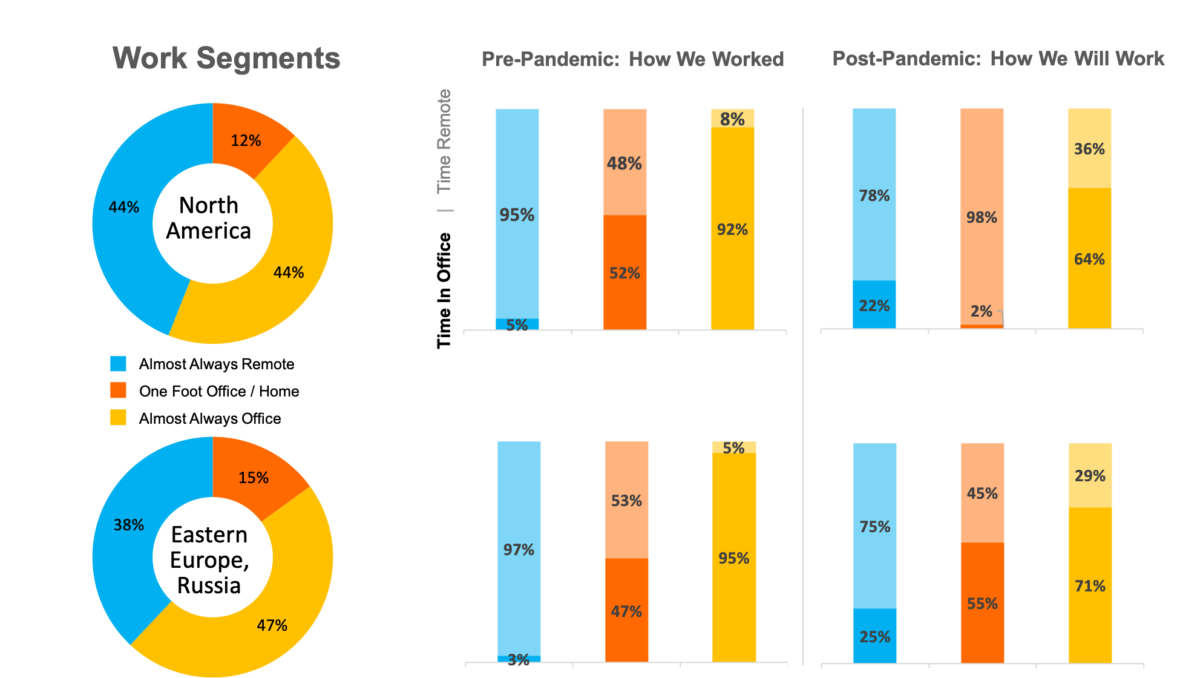The future of how market researchers will work in North America
To provide perspective on work trends among market researchers in North America, we conducted a quantitative survey of market researchers in North America (primarily in the U.S. and several in Canada). We asked the following questions:
1.) What percent of time did you work remotely last year?
2.) What percent are you working remotely now?
3.) What is your projection about the percent of your work that will be remote a year from now?
We gathered data after surveying market researchers in the U.S. and Canada covering more than a dozen states and provinces.
When analyzing the data, we split it up into three segments:
- Those who primarily work from home a year before the pandemic (Almost) always remote)
- Those splitting time between remote and in-office (One foot in the office, one foot at home)
- Rhose primarily in an office before the pandemic (Almost) always in the office)
Here were the results in North America:
Nearly half of the researchers we surveyed in North America were already working primarily from home even before the pandemic. Surprisingly, more people in that group were either working more often in an office now or projecting they would after the pandemic.
On the flip side, researchers primarily working in an office before the pandemic are primarily working remotely now: they anticipate working remotely more often after the pandemic, but still spending the bulk of their time in a physical office.

The future of how market researchers will work in Eastern Europe and Russia
We surveyed respondents across Russia, Ukraine, Kazakhstan, Kyrgyzstan and Poland, asking them the same questions as the market research professionals who participated in North America.
We decided to analyze in the same way as we did in North America to compare how each regions’ market researchers have been working. Here is what we found:
We see some striking similarities when comparing market researchers’ remote work trends pre- and post-pandemic across the three groups we created. While the baseline of those who were working primarily remotely pre-pandemic is closer to one-third, their trends from pre- to now to post-pandemic are very similar to what we found among North American researchers. That is, more of them project to work in an office setting at least some of the time following the pandemic. Again, they are either desiring or accepting a more hybrid approach. Those who were primarily working in an office before the pandemic believe they will be spending more time working remotely even after the pandemic compared to their workflow before it.
Actionable tips for research firms to implement a hybrid model
Finally, we wanted to offer readers quick tips on how to practically move forward with a hybrid work model, as that is what our research tells us is going to be the future for many of our colleagues in market research.
- Set internal ground rules for when to use shared apps like WhatsApp — i.e. set “out of the app” hours
- Establish a secure connection between home computers and work computers
- Be intentional about the time you spend together — celebrate social gatherings together in person
- Prioritize which tasks are best to do remote and in-person (i.e. report writing — maybe best to do remotely; data analysis — maybe better in a group setting)
Remote work will continue to be a way for market researchers to accomplish important tasks. But, whether we’re in North America or many time zones away in Eastern Europe and Russia one thing is for certain: At some point, we’ll likely be gathering together in an office setting again, at least for parts of our work week.


